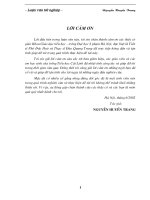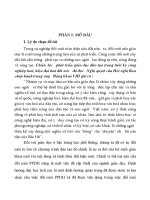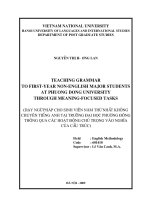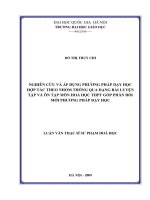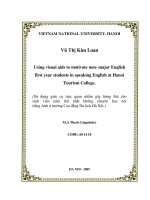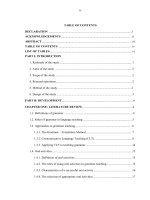Nghiên cứu việc sử dụng phương pháp dạy kĩ năng đọc theo đường hướng giao nhiệm vụ cho sinh viên năm thứ nhất không chuyên ngữ tại trường cao đẳng kinh tế công nghiệp hà nội
Bạn đang xem bản rút gọn của tài liệu. Xem và tải ngay bản đầy đủ của tài liệu tại đây (1.16 MB, 60 trang )
VIETNAM NATIONAL UNIVERSITY, HANOI
UNIVERSITY OF LANGUAGES AND INTERNATIONAL STUDIES
FACULTY OF POST-GRADUATE STUDIES
*******************
LÊ THỊ THÚY
AN INVESTIGATION INTO THE USE OF TASK-BASED METHOD IN
TEACHING READING FOR THE FIRST YEAR NON-ENGLISH MAJOR
STUDENTS AT HANOI COLLEGE OF INDUSTRIAL ECONOMICS
(NGHIÊN CỨU VIỆC SỬ DỤNG PHƯƠNG PHÁP DẠY KĨ NĂNG ĐỌC THEO
ĐƯỜNG HƯỚNG GIAO NHIỆM VỤ CHO SINH VIÊN NĂM THỨ NHẤT KHÔNG
CHUYÊN NGỮ TẠI TRƯỜNG CAO ĐẲNG KINH TẾ CÔNG NGHIỆP HÀ NỘI)
M.A. MINOR PROGRAMME THESIS
Field: English Teaching Methodology
Code: 60140111
Hanoi, 2014
VIETNAM NATIONAL UNIVERSITY, HANOI
UNIVERSITY OF LANGUAGES AND INTERNATIONAL STUDIES
FACULTY OF POST-GRADUATE STUDIES
*******************
LÊ THỊ THÚY
AN INVESTIGATION INTO THE USE OF TASK-BASED METHOD IN
TEACHING READING FOR THE FIRST YEAR NON-ENGLISH MAJOR
STUDENTS AT HANOI COLLEGE OF INDUSTRIAL ECONOMICS
(NGHIÊN CỨU VIỆC SỬ DỤNG PHƯƠNG PHÁP DẠY KĨ NĂNG ĐỌC THEO
ĐƯỜNG HƯỚNG GIAO NHIỆM VỤ CHO SINH VIÊN NĂM THỨ NHẤT KHÔNG
CHUYÊN NGỮ TẠI TRƯỜNG CAO ĐẲNG KINH TẾ CÔNG NGHIỆP HÀ NỘI)
M.A. MINOR PROGRAMME THESIS
Field: English Teaching Methodology
Code: 60140111
Supervisor: Phạm Thị Thanh Thùy, Ph.D
Hanoi, 2014
i
DECLARATION
I, Le Thi Thuy, hereby state that this thesis entitled “An Investigation into
the Use of Task – Based Method in Teaching Reading for the First year non-English
Major Students at HaNoi College of Industrial Economics” is the result of my own
research in partial fulfillment of the requirements for the degree of Master of Arts at
Faculty of Post Graduate studies – University of Languages and International
Studies-Vietnam National University
Hanoi, September, 2014
Signature
Lê Thị Thúy
ii
ACKNOWLEDGEMENTS
I would like first and foremost to thank Dr. Pham Thi Thanh Thuy - my
thesis supervisor - for her critical comments and valuable guides without which this
thesis could not have been completed. I would also like to express my thanks to the
lecturers and the staff of the Postgraduate Department at University of Languages
and International Studies for their useful lectures and careful guidance.
My sincere thanks go to all my colleagues and my students at Hanoi college
of Industrial Economics. And I also wish to express my thanks for the great
cooperation from the first year students in the classes: CKT13.1, CKX13.4,
CKX13.2 and CQS13.1 in the data collection of my study.
Last of all, I would like to express my thanks to my family, especially my
husband for their sacrifice and encouragement.
iii
ABSTRACT
At HCIE, reading is one of the most important skills in learning English.
Therefore, how to teach reading well and effectively has been concern of the
teachers. In the past, the common teaching method applied in this college is
Grammar- Translation Method. However, this method is not effective in teaching
reading. Among the modern teaching methods, Task-Based Method (TBM) is
considered a new and effective one. Task-Based Method has been tried by many
English teachers at HCIE. The main purpose of this research paper is investigating
the real situation of teaching reading skills at HCIE for the first year students and
providing some suggestions for using TBM to improve teaching reading skills at
HCIE. To gain these objectives, three kinds of instruments are applied such as
survey questionnaire, class observation and informal interview.
iv
LIST OF ABBREVIATIONS
HCIE: Hanoi College of Industrial Economics
Ss: Students
Ts: Teachers
TBM Task Based Method
GTM Grammar Translation Method
OU Open University
ULIS, VNUH University of Languages and International
Studies, Vietnam National University,
Hanoi
v
LIST OF TABLES AND FIGURES
TABLES
Table 1: Students’ and teachers’ attitude toward the reading materials
Table 2: Students’ assessments on teachers’ activities in reading lessons
Table 3: Students’ performance in reading lessons
Table 4: Teachers’ frequencies of using activity management in reading lessons
Table 5: Teachers’ activities at pre-reading stage
Table 6: Teachers’ activities at while-reading stage
Table 7: Teachers’ activities at post-reading stage
FIGURES
Figure 1. Willis’ (1996) TBM framework
Figure 2: Ellis (2006) Classroom processes Traditional form-focused teaching
method and Task-Based Method
vi
TABLE OF CONTENTS
Declaration i
Acknowledgements ii
Abstract iii
List of abbreviations iv
List of tables and figures v
Table Of Contents vi
PART A: INTRODUCTION 1
1. Rationale of the study 1
2. Aim of the study 2
3. Research questions 2
4. Scope of the study 2
5. Design of the study 2
PART B: DEVELOPMENT 4
CHAPTER 1: LITERATURE REVIEW 4
1.1. Reading skills 4
1.1.1. Definition of reading 4
1.1.2. Definition of reading comprehension 4
1.1.3. The Goals of teaching Reading skills 5
1.2. Task - based Method 7
1.2.1. What is task 7
1.2.2. Type of tasks 8
1.2.3. A framework for TBM Implementation 10
1.2.4. Task - Based Method (TBM) and Traditional Teaching Method 12
1. 2.5. Task - Based Method in teaching reading skills 15
CHAPTER 2: METHODOLOGY 16
2.1. Background to the study 16
2.1.1 Teachers and students 16
2.1.2. The textbooks 16
vii
2.1.3. The teaching and learning facilities 17
2.2 Design and methodology 17
2.2.1. Participants 17
2.2.2. Instruments 18
2.2.3. Data collection procedures 19
CHAPTER 3: FINDINGS AND DICUSSION 21
3.1. Current situation of English reading lessons in classroom at HCIE 21
3.1.1. Students’ and teachers’ attitude toward the reading materials 21
3.1.2. Students’ assessments on teachers’ activities in reading lessons 22
3.1.3. Students’ performance in reading lessons 23
3.1.4. Teachers’ frequencies of using activity management in reading
lessons 24
3.1.5. Teachers’ activities at pre- reading stage 25
3.1.6. Teachers’ activities at while-reading stage 26
3.1.7. Teachers’ activities at post-reading stage 27
3.2. Some suggestions for using TBM to improve teaching reading skills 29
3.2.1. Suggestions for students 29
3.2.2. Suggestions for teachers 30
3.2.3. Suggestions for administrator 32
PART C: CONCLUSION 34
1. Summary of major findings 34
2. Limitations of the study and suggestions for further study 34
REFERENCES 35
APPENDIXES I
1
PART A: INTRODUCTION
1. Rationale of the study
Up to date, English becomes a dominant international language in all aspects
such as communication, science, aviation, entertainment, education. In Vietnam, it
is undeniable that it has become the most popular foreign language to be used as a
means of communication. Therefore, teaching and learning English is now
considered as a necessity in the society with the aim of mastering an international
language. Together with the development of language, language teaching
methodology has also developed to find the effectiveness of teaching and learning.
At HCIE, the system of the grammar and reading texts based exams is
dominated. So the students are eager to learn grammar points and do reading
exercises in workbooks as much as possible in order to pass the exam only.
Therefore, developing reading comprehension ability is a basic content in this
college. And how to teach reading effectively has been the concern of the teachers.
Some years ago, the situation of teaching reading at HaNoi college of Industrial
Economics was not satisfactory, because many teachers still used Grammar –
Translation Method, which did not attach enough importance to the improvement of
learners' communicative competence. As a teacher for four years in this college, the
researcher realizes that the grammar translation method is not really effective for
our students.
Meanwhile Task-Based Method which has been strongly advocated and
promoted by many world-leading linguists (Prabhu 1987, Nunan 1989, Willis 1996,
Skehan 1998, Bygate & Ellis 2001) since early 1980s. TBM has been tried by
many English teachers at HCIE. When the teachers use the TBM in reading class,
the situation of teaching and learning reading is totally different.
For these main reasons above, the researcher determined to conduct this
research work entitled:
“An Investigation into the Use of Task-Based Method in Teaching Reading
for the First year non-English Major Students at HaNoi College of Industrial
2
Economics”.
2. Aims of the study
The study aims to:
- Investigate the real situation of teaching reading skills for the first year non
-English major students at HCIE.
- Provide some suggestions for using TBM to improve teaching reading
skills at HCIE.
3. Research questions
There are two research questions for the study as follows:
Question 1: How are reading skills taught at HCIE?
Question 2: What might be some suggestions for using TBM to improve
teaching reading skills at HCIE?
4. Scope of the study
The focus of the study was on investigation of using Task-based Method in
teaching reading skills and the participants of the study are the first-year students at
the Hanoi college of Industrial.The information obtained from this study is to help
to improve teaching and learning English reading comprehension.
5. Design of the study
The study includes three main parts:
The first part is the Introduction. The researcher states the rationale for
choosing the topic of the study, the aim, the scope and the design of the study.
The second part is the Development which is divided into three chapters.
Chapter one provides the background knowledge of reading skills and Task-Based
Method. The next chapter refers to the background to the study. Then the author
provides the methodology of the study which describes the participants and
instruments, as well as the procedures employed to carry out the research. Findings
and discussion are followed in the next chapter by presenting and analyzing the
findings that the researcher discovered from the data collected and raises some
discussion related to the current situation of teaching reading at HICE with Task-
3
Based Method, then give some suggestions for using TBM to improve teaching
reading skills.
The last part is the Conclusion. This part presents the summary of major
findings, the limitations of the study and suggestions for further research.
4
PART B: DEVELOPMENT
CHAPTER 1: LITERATURE REVIEW
1.1.Reading skills
1.1.1. Definition of reading
Beck and Margaret (2005) described “Reading as a complex process
composed of a number of interacting sub-processes and abilities”. However, Pang
et all (2003, p. 6) have defined reading as a “complex activity that involves both
perception and thought”. Meanwhile Flesch (1955: 110), defines "reading as getting
the meaning of words formed by letters on a printed page and nothing else". This
opinion is as the same as Harris (1970: 3), he defines "reading as the meaningful
interpretation of written or printed verbal symbols”. Goodman (1995) explains that
“reading is the process of constructing meaning through the dynamic interaction
among the reader's existing knowledge, the information suggested by the written
language, and the context of the reading situation” Clearly, reading is an act that
involves the reader works to find out the meaning written by the writer.
Obviously, different scholars give different reading definitions and it is a
hard job to decide which is better because each of definition focuses on one
important matter of reading. However, the authors share the same ideas that reading
is the reader's perception and apprehension of the words written by the writer, and
thus upon understanding of the meaning he intends to convey.
1.1.2. Definition of reading comprehension
In order to instruct students in reading comprehension strategies, teachers
must first understand the meaning of reading comprehension.
Pang et al (2003) described “reading comprehension as an active process a
reader made to construct meaning from a text. This process which consists of using
an interaction between a prior knowledge, and drawing inferences from the
different words and expressions the writer uses, in order to comprehend
information, ideas and viewpoints”. Smith (1985) also believes that “reading
comprehension involves bringing a prior knowledge interacted with what she is
5
reading, so that she can achieve comprehension”. According to Block et al (2002,
p. 5), “reading comprehension is an interactive process involving the reader, the
text, and the context”.
In brief, reading comprehension is the process of obtaining the information
and understanding meaning from a piece of text.
1.1.3. The Goals of teaching reading skills
According to Sadoski, M (2004: 44) the goals of teaching any subject is
classified in one or more of three great domains which include the psychomotor
domain, the affective domain and the cognitive domain.
The psychomotor domain is the domain of the mind and the body working
together to produce physical performances. Learning to walk, tie shoelaces, swim,
type, drive a car, and perform creative dance routines are example of psychomotor
domain.
The affective domain is the domain of attitudes, interests, values,
appreciation, and life adjustment. The common examples of affective activities are
responding positively to success and constructively to failure, adopting healthy
habits over unhealthy ones, developing a democratic tolerance for opposing points
of view, or invoking ethical principles for behavior in morally ambiguous situations.
The cognitive domain is the domain of intellectual skill including the recall
or recognition of information, the comprehension of information, and the
development of logical and rational thought skills such as analysis, synthesis, and
evaluation. The common examples of cognitive activities are remembering facts,
summarizing thoughts, applying principles to solve problems, deducing a coherent
explanation from disparate pieces of evidence, or objectively critiquing arguments
in terms of their logical consistency.
In applying these domains in teaching reading skills, the goals of teaching
reading were divided into small goals which were balanced between the affective
domain and the cognitive domain, and the psychomotor domain was eliminated.
6
Two goals in the affective domain are developing positive attitudes toward reading
and developing personal interest and tastes in reading.
Goal 1: Developing positive attitudes toward reading
It is important to observe and recognize the attitudes of students toward
reading skills. The term “attitude” applies to their perceptions of their competence
and their dis-position toward their future performance. Students try to develop the
positive attitude toward reading means progressing in their confidence in their own
ability. Added to that, they should experience success regularly and approach
reading confidently and avoid the negative attitude.
Goal 2: Developing personal interest and tastes in reading
Having a positive attitude toward readinng is not enough. Students who have
an interest in reading have the motivation to read and to respond affectively, to seek
to enlarge self-understanding and sense of self-worth through reading. The
development of interest is the development of discriminating value judgment, or
taste which means that students can have tendency to make value choices and
judgments about what they chose to read and to develop their own critical
standards.
Two goals in the cognitive domain are developing the use of reading as a
tool to solve problems and developing the fundamental competences of reading at
successfully higher levels of independence.
Goal 3: Developing the use of reading as a tool to solve problems
Reading is a way to deal with everyday problems because printed language
which need reading is everywhere, such as memos and menus, candy wrappers,
constitutions, bills and rest room doors, resumes and rest room doors, etc. Reading
helps readers know their meanings and for which they are used. Clearly, using
reading as a tool in our daily lives is pervasive.
Goal 4: Developing the fundamental competencies of reading at succeedingly
higher levels of independence.
7
This is the most basic goal and provides the means to the other ends.
According to Chall (1996: 18), reading is classified into six stages with specific
goals:
Stage 0, Pre-reading (prekindergarten–grade 1):developing concepts about print;
recognizing print in the environment; learning some letters and words.
Stage 1, Initial Reading or Decoding (grades 1–2): learning letters and letter
combinations and their correspondence with parts of spoken words; learning to crack the
code.
Stage 2, Confirmation, Fluency, Ungluing from Print (grades 2–3): learning more
about decoding; using context to increase fluency and rate; reading simple stories and
beginners’ books.
Stage 3, Reading for Learning the New: A First Step (grades 4–8): learning to read
begins to shift to reading to learn; developing vocabulary and knowledge; beginning to use
subject area textbooks.
Stage 4, Multiple Viewpoints (high school): dealing with more mature texts that
introduce varying viewpoints and more challenging concepts; more independent reading.
Stage 5, Construction and Reconstruction - A World view (college and adult): more
advanced and discriminating reading; constructing knowledge on a high level of abstraction and
generality; varying purposes and rate; critical reading.
(Chall 1996: 18)
To sum up, in teaching reading skills, considering these goals helps us to
imagine an ideal state of affairs in a reading class and provide a conceptual basis
for the why of teaching reading. Also, a complete reading curriculum needs to
address the affective as well as the cognitive, attitude as well as ability, interest as
well as skill.
1.2. The Task – Based Method
1.2.1. Definition of “task”
A number of definitions of task have been suggested:
According to Nunan (2004) “a task is a piece of classroom work involving
learners in an understanding, directing, producing or interacting way in the target
language while the students' attention is focused on activating their grammatical
8
knowledge in order to express meaning, and in which the aim is to express meaning
rather than to manipulate form”.
Bachman & Parmer (1996) define a task as “an activity that involves
individuals in using language for the purpose of achieving a particular goal or
objective in a particular situation”. In this definition, the authors stress the presence
of a specific objective in an activity.
Richards, Platt & Weber (1986) offered a pedagogical definition: "task is an
activity or action which is carried out as the result of processing or understanding
the language" (p.289). This definition implies that tasks involve communicative
language use in which the user’s attention is focused on meaning rather than
linguistics structure. Another point of view comes from Caroll (1993). He considers a
task as: “any activity in which a person engages, given an appropriate setting, in
order to achieve a specifiable class of objectives”. This definition mentions the
importance of engaging within an activity. This means that our students are
confident with the language they use because the previous tasks will help them to
perform sucessfully what has been asked to do.
To sum up, there are a lot of different definition of task in English teaching,
but the main focus of task is an activity in which students use language to achieve a
specific goal. It is on the authentic use of language for meaningful communicative
purposes beyond the language classroom, which has some connections with a real
world of learners' lives and learning experience, and which can arouse learners'
interest and participation.
1.2.2. Types of Task:
Different writers have different ways to classify tasks:
Pica et al. (1993), for instance, classify tasks as per interaction sorts in the
product like (a) jigsaw, (b) information-gap, (c) problem-solving, (d) decision-
making, and (e) opinion exchange.
Willis (1996) classifies six types of task as per knowledge hierarchies as (a)
listing, (b) ordering and sorting, (c) comparing, (d) problem solving, (e) sharing
9
personal experience, and (f) creative.
a. Listing:
Listing tasks tend to get a lot to talk as learners explain their ideas. This type
of task involved brainstorming and fact-finding. The outcome of this task may be
completed list and draft mind map.
b. Ordering and sorting:
Ordering and sorting tasks involve four main types: Categorizing items in
given groups or grouping them under given headings; classifying items in different
ways; sequencing items, actions or events in a logical or chronological order and
ranking items. The outcome of this task may be set of information ordered sorted
according to specific criteria.
c. Comparing:
Comparing tasks involves comparing information to identify similarities and
things in common and differences. The outcome of this task could be items
appropriately matched or assembled or the identifications of similarities and/or
differences.
d. Problem solving:
Problem-solving tasks make demands upon people’s intellectual and
reasoning powers, and though challenging, they are engaging and often satisfying to
solve. The processes and time scale will vary enormously depending in the type and
complexity of the problem. Real-life problems may involve expressing hypotheses,
describing experiences, comparing alternatives and evaluating and agreeing a
solution. The outcome of this task may be solutions to the problem, which can then
be evaluated.
e. Sharing personal experiences:
Tasks of sharing personal experiences encourage learners to talk more freely
about themselves and share their experiences with others. Learners have an
10
opportunity narrating, describing, exploring and explaining their attitudes, opinions
or reactions. The outcome of this task may be largely social.
f. Creative tasks
This task involve pairs or groups of learners in some kind of freer creative
work. They also tend to have more stages than other tasks and can involve
combinations of task types above. The outcome can be appreciated by a wider
audience.
Prabhu identifies three kinds of cognitive task types:a) information-gap, b)
opinion-gap and c) reasoning-gap tasks:
a. An information-gap activity involves the exchange of information among
participants in order to complete a task.
b. An opinion-gap activity requires that students give their personal preferences,
feelings, or attitudes in order to complete a task.
c. A reasoning-gap activity requires students to derive some new information by
inferring it from information they have been given.
From the authors’ classifications, the researcher sees that although
the tasks seem to be different, they all stress the importance of activity to create an
effective learning environment in the classroom for learners to use the target
language for real communication and engage in the learning process.
1.2.3. A framework for TBM Implementation
Willis’ Task-Based Learning Framework (Willis, 1996) offers teachers a
practical guide for conducting tasks in the classroom, the framework consists of
three phases: Pre-task, task cycle and language focus.
(i) The pre-task, Willis (1996) identifies three steps for pre-task stage:
In this stage, teacher explores the topic with class, activating topic related
words and phrases. Students note down useful words and phrases, spend time
preparing for the individual task. The pre-task phase will usually be the shortest
stage in the framework. It could last between two and twenty minutes, depending on
learners’ degree of familiarity with the topic and the type of task.
11
(ii) The task cycle: This is the main task stage including three components:
(a) task: students work in pairs or small groups and the teacher monitors from a
distance; b) planning: students prepare to report to the whole class orally or in
writing how they did the task and what they decided or discovered; and (c) report:
some groups present their reports to the class or exchange written reports, and then
they compare results.
The task cycle offers students the chance to use the language they already
know and to improve the language under teacher guidance. Students gain fluency
and confidence during the task stage. They then improve the language during the
planning stage with access to the teacher's help when they need it. The report stage
gives students motivation to improve upon the language they use. At the end of
the task cycle, students are provided with recordings or texts which provide familiar
contexts for the teaching of grammar.
(iii) The language focus phase: Finally, the language focus phase can be further
divided into two components: (a) analysis: students examine and discuss specific
features of the text or transcript of the recording; and (b) practice: teacher conducts
practice of new words, phrases, and patterns occurring in the data either during or
after the analysis. In this stage, students have opportunities to see grammar rules in
use, learn the rules explicitly, and practice the target forms.
All these phases can be summarized into the following table:
PRE-TASK
Teacher
explores the topic
Students
note down useful words and phrases,
spend time preparing for the individual task
TASK CYCLE
12
TASK
Students
do the tasks in pairs or small
groups
Teacher
monitors and encourages
communication
PLANNING
Students
prepare to report to the class
Teacher
provides language advice
REPORT
Students
present reports
Teacher
acts as chair person
and
providefeedback
LANGUAGE FOCUS
ANALYSIS
Students
examine and discuss features of the text enter
new words or phrases
Teacher
reviews and analyses the activity
PRACTICE
Teacher
conducts practice of new words,
phrases
Students
practice the task
Figure 1. Willis’ (1996) TBM framework
1.2.4. Task-Based Method (TBM) and Traditional focus-formed Teaching
Method
For many years, language teaching was dominated in my college is the
traditional focus-formed Teaching Method, more specific so called Grammar
Translation Method. This method focuses on form and is featured as teacher-
centered. The major characteristics of the method include explicit teaching of
grammatical rules, memorization of vocabulary lists, and translation of passages
from native language to the second language. Obviously, this method has
advantages. Firstly, translation is the easiest way of explaining meanings or words
and phrases from native language into the second one. There will be time-
13
consuming if the meanings of lexical items are explained through definitions and
illustrations in the second language. Secondly, teacher and students are easy to
communicate. Students will be easier to respond teacher’s questions and understand
grammatical competence on the mother tongue. However, it seems that its
disadvantages are much greater. Firstly, the students are eager to learn grammar
points and do exercises in their workbooks as much as possible in order to pass the
exam only. For a long time, they cannot speak English fluently, even a basic
conversation in English because classes with this method are usually taught in a
lecture style, with the teacher mostly speaking the students’ native language rather
than English.
Realizing Grammar Translation Method was not really effective in helping
students learn reading skills as well as other skills, the Faculty of Foreign
Languages decided to change the teaching method from GTM into Task-Based
Method in teaching reading skill and other skills. This is an effective method to
enhance our reading ability to read the various kinds of information in our daily life.
Therefore, TBM can develop students’ reading skills more effectively. Obviously,
these two main kinds of method are totally different. Ellis (2006) contrasts two sets
of classroom processes in traditional form -focused teaching method and Task-
Based Method as follows:
Traditional form-focused teaching
method
Task - Based Method
Rigid discourse structure consisting of
IRF (initiate-respond-feedback)
exchanges
Loose discourse structure consisting
Teacher controls topic development
Students able to control topic development
Turn-taking is regulated by the teacher.
Turn-taking is regulated by the same rules
that govern everyday conversation
Display questions (i.e. questions that the
Use of referential questions (i.e. questions
14
questioner already knows the answer)
that the questioner does not know the
answer to)
Students are placed in a responding role
and consequently perform a limited
range of language functions.
Students function in both initiating an
responding roles and thus perform a wide
range of language functions (e.g. asking
and giving information, agreeing and
disagreeing, instructing).
Little need or opportunity to negotiate
meaning.
Opportunities to negotiate meaning when
communication problems arise
Scaffolding directed primarily at
enabling students to produce correct
sentences.
Scaffolding directed primarily at enabling
Ss to say what they want to say
Form-focused feedback (i.e. the teacher
responds implicitly or explicitly to the
correctness of students’ utterances)
Content-focused feedback (i.e. the teacher
responds to the message content of the
students’ utterances).
Echoing (i.e. the teacher repeats what a
student has said for the benefit of the
whole class
Repetition (i.e. a student elects torepeat
something another student or the teacher
has said as private speech or to establish
intersubjectivity).
Figure 2: Classroom processes Traditional form-focused teaching method and Task
– Based Method (Rod Ellis, 2006)
Unlike Grammar-Translation Method which focuses on form to develop
grammar competence, Task-based method focuses on form to develop the
meaningful communication and the cooperation between learners and the teacher.
Grammar – Translation Method gives students few opportunities to really use the
language for communication. TBM, on the other hand, allows students to find new
language when they want to, and use language experimentally and creatively in real
communication.
15
As a teacher for four years in this college, the researcher sees that Grammar
Translation Method is not really effective for her students, which leads the
researcher does the research on using Task-Based Method in teaching reading for
the first year non – English major students at HCIE and then give some suggestions
for improving teaching reading skills.
1.2.5. Task-Based Method in teaching reading skills
Task-based Method aims to promote the students’ ability of reading
comprehension without ignoring the language structure and grammar points. When
applying TBM in the lessons, students' communicative ability is also developed.
In Task-Based reading classes, every student has certain responsibility and
plays a certain role in Task-Based activities. They use language they have achieved
to exchange information, ideas and even thei emotion relating to the reading texts.
As the result, in the process of task-accomplishing, students have to use more than
one strategy to complete their reading tasks. They should use two or more skills and
more linguistic knowledge in order to finish the tasks. In this way, their ability to
use language is improved. Besides, the activities which teachers apply in the
classroom should relate to students’ life experience or social problems they are
facing to or going to experience in their daily life. Otherwise, they will feel bored
when taking part in the activities.
Finally, teachers should act as a coordinator and an instructor in reading
activities. They should transform their teaching thought fundamentally and aims to
develop students’ reading ability and language use ability. Besides, they should
instruct students to use proper reading skills and encourage them to read
independently.
16
CHAPTER 2: METHODOLOGY
2.1. Background to the study
2.1.1. .Teachers and students
The Faculty of Foreign Language at HCIE consists of twenty teachers whose
ages ranged from 24 to 48. 13 of them have got an M.A degree. 7 are studying post
graduate course. In general, most of them are energetic, enthusiastic, responsible
and willing to adjust new method to improve their teaching quality.
The first year non - English major students at HCIE are at the age from 18 to
20 with the majority of female students. Despite having 7 years of studying English,
their level is not high. Most of them come from rural areas in Vietnam and they do not
have good condition to learn English. Moreover, their attitude toward learning
English is not good. At HCIE, English is thought to be as a general subject which is
not as important as other subjects, so students do not spend much time to master it.
They come to class to pass English exams only. Actually, they hardly prepare
lessons at home or review the lessons regularly. Besides, the majority seem to have
limited background knowledge, and poor vocabulary. When dealing with new
words, unfamiliar concepts or complicated sentence structures, they often ask their
teachers or look up the dictionary without deducing the meaning from the text by
themselves. In addition, they are not enthusiastic and confident enough to
participate into the activities which their teachers provide. To conclude, most
students at HCIE land themselves in a passive position in reading class. They are
accustomed to the traditional lecture – oriented methods and teacher- centered
classrooms at secondary as high schools. Therefore, it is teacher’s responsibility to
encourage learners, inspire their confidence and help them learn collaborative skills
necessary for successful completion of task – based activities because learners’
active participation in task – based performance in the essence of successful
language learning process.
2.1.2. Textbooks
The textbook used for the first year non-major students in English for

